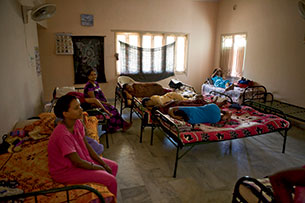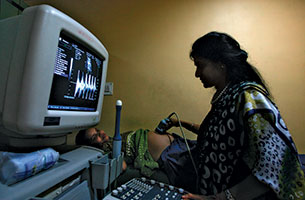
Illustration: Tomer Hanuka
From its pockmarked exterior walls and stark interior, you’d never guess that the pink three-story building tucked in a narrow alley a few blocks from the train station in the fast-growing city of Anand houses India’s most successful surrogate childbirth business. But this is the place they raved about on Oprah. Nowadays, thanks to the endorsement of daytime TV’s leading lady, the Akanksha Infertility Clinic fertilizes eggs, implants and incubates embryos, and finally delivers contract babies at a rate of nearly one a week.
Doctor Nayna Patel, Akanksha’s founder, has just finished washing up after delivering twins by cesarean section. A team of nurses ushers me into her office from an adjoining one where I’ve had a chance to peruse a stack of press clippings lauding her accomplishments and contributions to international fertility. For the last three to four years, Patel has been the subject of dozens of gushing articles in addition to that game-changing 2007 Oprah segment, which all but heralded Patel as a savior of childless middle-class couples and helped open the floodgates for the outsourcing of American pregnancies. Patel took the publicity to the bank—autographed photos of Ms. Winfrey are displayed prominently throughout the clinic, which claims a waiting list hundreds deep and receives at least a dozen new inquiries from potential surrogacy customers each week.
The doctor, clad in a bright red-and-orange sari, sits at a large desk that covers about a third of the room. Heavy diamond jewelry dangles from her neck, ears, and wrists. Her wide grin projects a mixture of politeness and caution as she beckons me to sit in a rolling office chair. I showed up here without an appointment, fearing Patel would refuse to see me if I phoned in advance: Despite all the laudatory press, in the weeks prior to my visit a spate of critical articles had appeared, focusing on the clinic’s controversial practice of cloistering its hired surrogate mothers in dormitories. Among the claims: Akanksha is little more than a baby factory. “The world will point a finger at me,” Patel responds when I ask about the criticism. “She will point, he will point. I don’t have to keep answering people for that.”
As if to prove it, she politely evades my questions for 20 minutes, and then escorts me out. I had hoped to get her take on the residency units, but it’s not a topic she cares to discuss.
On a quiet street about a mile from the clinic, a government ration shop issues subsidized rice to an endless stream of impoverished clients. Across the road is a squat concrete bungalow enclosed by concrete walls, barbed wire, and an iron gate. Police once used the site as a storehouse for bootleg liquor captured in Eliot Ness-style raids. (Like the rest of India’s Gujarat state, Anand is a dry city.) The security measures were intended to keep away bootleggers who might be tempted to reclaim the evidence. Now the building functions as one of two residential units for Akanksha’s surrogates.
 Akanksha surrogates spend their entire pregnancies within guarded residential facilities. The clinic claims they live better here than at home. Scott Carney
Akanksha surrogates spend their entire pregnancies within guarded residential facilities. The clinic claims they live better here than at home. Scott Carney
The women—all married and with at least one previous child—have traded the comforts of home to enroll as laborers in India’s burgeoning medical tourism industry. Most will spend their entire pregnancies living in this building. In exchange for the inconvenience and physical discomforts, they stand to receive a sum that’s quite substantial by their meager standards, but which the clinic’s customers understand is a steal. The customers are mostly foreigners—three of the city’s boardinghouses are constantly booked with American, British, French, Japanese, and Israeli surrogacy tourists.
After a few minutes of recon, I cross the street to the bungalow, where a friendly smile gets me past the gatekeeper. In the hostel’s main living quarters, some 20 nightgown-clad women in various stages of pregnancy lie about, conversing in a hurried mix of Gujarati, Hindi, and a bit of English. A lazy ceiling fan stirs the stagnant air, and a TV in the corner—the only visible source of entertainment—broadcasts Gujarati soaps. The classroom-size space is dominated by a maze of iron cots that spills out into a hallway and additional rooms upstairs. It is remarkably uncluttered given the number of people living here—each surrogate has only a few personal belongings, perhaps enough to fill a child’s knapsack. In a well-stocked kitchen down the hall, an attendant who doubles as the house nurse prepares a midday meal of curried vegetables and flatbread.
The women are pleasantly surprised to see me. It’s rare, one tells me, for a white person to show up here. The clinic discourages personal relationships between clients and surrogates, which according to several people I talked with makes things easier when it comes time to hand over the baby.
Through an interpreter, I tell the women that I’m here to learn more about how they live. Diksha, a bright, enthusiastic woman in her first trimester, elects herself spokeswoman, explaining that she used to be a nurse at the clinic. She left her home in neighboring Nepal to find work in Anand, leaving her two school-age children behind. She’ll use the money she makes to fund their education. “We miss our families, but we also realize that by being here we give a family to a woman who wants one,” Diksha says.
She and her dormmates are paid $50 a month, she says, plus $500 at the end of each trimester, and the balance upon delivery. All told, a successful Akanksha surrogate makes between $5,000 and $6,000—a bit more if she bears twins. If a woman miscarries, she keeps what she’s been paid up to that point. But should she choose to abort—an option the contract allows—she must reimburse the clinic and the client for all expenses. No clinic I spoke with could recall a surrogate going that route.
Diksha is the only Akanksha surrogate I meet who has an education to speak of. Most of the women hail from rural areas; for some, the English tutor Patel sends to the dormitories several times a week is their first exposure to anything resembling schooling. But they’re not here to learn English. Most heard about the clinic via local newspaper ads promising straight cash for pregnancy. (Kristen Jordan, a 26-year-old California housewife I met later, told me she opted for a Delhi clinic that recruits educated surrogates and doesn’t cloister them after she learned that some clinics hire “basically the very, very poor, strictly doing it for the money.”)
Among the justifications for cloistering the surrogates—Akanksha isn’t the only clinic doing it—is to facilitate medical monitoring and provide the women better living conditions than they might have back home. For their part, the women tell me their condition would almost certainly make them the subject of village gossip.
Even so, those who have been on the ward longer than Diksha don’t seem terribly thrilled with the whole setup. I sit down next to Bhavna, far along and bulging in her pink nightgown, with a gold locket around her neck. She looks older than the rest—tired. It’s her second surrogacy here, she tells me. Apart from occasional medical checkups, she hasn’t left this building in nearly three months, nor had any visitors. But $5,000 is more than she would make in years of ordinary labor. Mostly she just looks forward to collecting her check and being done with it.
I ask for her view of the overall experience. “If we have a miscarriage we don’t get paid the full amount; I don’t like that,” she says. But she’s thankful to be here and not at the clinic’s other hostel, a few towns away in Nadiad, which isn’t as nice. When I ask what happens after she hands over the baby, she replies that the cesarean section will take its toll. “I will stay here another month recovering before I am well enough to go home,” Bhavna says. (Not a single surrogate I interviewed expected a vaginal birth, even though C-sections are considered riskier for the baby under normal circumstances and double to triple the woman’s risk of death during childbirth. They are, however, far faster than vaginal labor—and some clinics charge clients extra for them.)
We’re joined by a second woman, who has dark brown eyes and wears a muumuu embroidered with pink flowers. I ask them whether they think they’ll have trouble handing over their newborns. “Maybe it will be easier to give up the baby,” says the second woman, “when I see it and it doesn’t look like me.”
India legalized surrogacy in 2002 as part of a long-term push to promote medical tourism. Since 1991, when the country’s new free-market policies took effect, private money has flowed in, fueling construction of world-class hospitals that cater to foreigners. Surrogacy tourism has grown steadily here as word gets around that babies can be incubated at a low price and without government red tape. Patel’s clinic charges about $15,000 to $20,000 for the entire process, from in vitro fertilization to delivery, whereas in the handful of American states that allow paid surrogacy, bringing a child to term costs between $50,000 and $100,000. “One of the nicest things about [India] is that the women don’t drink or smoke,” adds Jordan, the Delhi surrogacy customer. And while most American surrogacy contracts also forbid such activities, Jordan says, “I take people in India more for their word than probably I would in the United States.”
Dependable numbers are hard to come by, but at minimum Indian surrogacy services now attract hundreds of Western clients each year. Since 2004, Akanksha alone has ushered more than 232 babies into the world through surrogates. By 2008, it had 45 surrogates on the payroll, and Patel reports that at least three women approach her clinic every day hoping to become one. There are at least 350 other fertility clinics around India, although it’s difficult to say how many offer surrogacy services since the government doesn’t track the industry. Mumbai’s Hiranandani Hospital, which boasts a sizable surrogacy program, trains outside fertility doctors to identify and recruit promising candidates. The Confederation of Indian Industry predicts that medical tourism, including surrogacy, could generate $2.3 billion in annual revenue by 2012. “Surrogacy is the new adoption,” says Delhi fertility doctor Anoop Gupta.
Despite the growth in services, surrogacy is not officially regulated in India. There are no binding legal standards for treatment of surrogates, nor has any state or national authority been empowered to police the industry. While clinics have a financial incentive to ensure the health of the fetus, there’s nothing to prevent them from cutting costs by scrimping on surrogate pay and follow-up care, or to ensure they behave responsibly when something goes wrong.
Last May, for instance, a young surrogate named Easwari died after giving birth at the Ishwarya Fertility Clinic in the city of Coimbatore. A year earlier, her husband, Murugan, had seen an ad calling for surrogates and asked her to sign up to earn the family extra money. As a second wife, Easwari was hard-pressed to refuse. The pregnancy went smoothly and she gave birth to a healthy child. But Easwari began bleeding heavily afterward, and the clinic was unprepared for complications. Unable to stop Easwari’s hemorrhaging, clinic officials told Murugan to book his own ambulance to a nearby hospital. Easwari died en route.
The child was delivered to the customer according to contract, and the fertility clinic denied any wrongdoing. But in a police complaint the husband suggested that the clinic had essentially dumped responsibility for his dying wife. The official investigation was perfunctory. (The clinic did not respond to emailed questions for this story.)
India’s parliament is in the process of crafting legislation to address some of the concerns about surrogacy. The bill could be ready for formal consideration sometime this year, but it is not clear which agency would be charged with enforcement. In any case, any regulatory oversight would likely fall to the states. “At the state level, no one looks at surrogacy,” says Sunil Avasia, Gujarat’s deputy director of medical services, whom I finally manage to interview after a great deal of bureaucratic runaround. When it comes to ethical conduct, it might as well be the Wild West. Forget laws, he says. “There are no rules.”
That’s all he has to offer on the topic. “Perhaps you should talk to my boss,” Avasia says. Alas, the boss won’t return my calls. There hasn’t been any effort to regulate surrogacy contracts on the receiving end, either. So long as a surrogate infant has an exit permit from the Indian government, the process for getting the baby an American passport is straightforward.
Some of Patel’s customers view the residency program as an insurance policy of sorts. “When I was told by my doctor they could get someone in Stockton [California], I don’t know what they’re eating, what they’re doing. Their physical environment would have been a concern for me,” says Sarah, a 40-year-old from Berkeley who runs a catering company with her husband and teaches Jewish ethics lessons to children. “The way they have things set up here is that the surrogate’s sole purpose is to carry a healthy baby for someone.”
I met Sarah (a pseudonym, per her request) in the hallways of the Laksh Hotel, which caters to Akanksha’s surrogacy tourists. For many, this India excursion represents the final stage of an expensive and emotional quest for genetic parenthood—their last option after a series of failed fertility treatments. She tried for years to conceive, and after extensive testing was told she never would. Adoption didn’t appeal to her. Then she read a news article about Patel and knew immediately that she wanted to come to Anand. “Money was definitely one of the reasons, but it was like my gut feeling,” she says. “This is where I needed to be.” Sarah and her husband resolved to keep their undertaking secret from friends and neighbors—at least until they returned home with a baby.
In the United States, a surrogate and her clients must establish a relationship before coming to a fertility clinic, but Sarah has barely met Saroj, the woman Akanksha hired to carry her child. They connected just once, briefly, at the clinic a few minutes after embryos from her eggs fertilized with her husband’s sperm were implanted in Saroj’s uterus. That was nine months ago. She’s been back in Anand for a few days, and hasn’t yet gone to visit Saroj, although she will spend time with her later. “The clinic wants to keep a separation,” Sarah tells me. “This is what your job is: I’m the mother. She’s the vessel.”
But this is where the ethos of commercial surrogacy becomes confusing. Sarah is quick to add that Saroj is giving her one of the most precious gifts a person can offer. “The clinic won’t let someone be a surrogate more than twice, because they don’t want to see themselves just as a surrogate,” she says. “That shouldn’t be a job.”
Then how to view it? Oprah showcased Jennifer and Kendall, a childless couple who had tried everything else but couldn’t afford the American surrogacy system. With Patel’s help, Jennifer became a mom, and an Indian woman was lifted from poverty—a transaction part business and part sisterhood. Yet it’s a setup fraught with all the ambiguities of the global labor market: When you buy sweatshop sneakers it allows someone’s family to eat. But you also know you’re getting a bargain only because the people making the shoes are poor.
Clinics work hard to present surrogacy—to surrogates and clients alike—as an act of altruism, and insist that the women offer their wombs out of a sense of communal responsibility, not simply because they need a paycheck. The boilerplate contracts Akanksha has its clients and surrogates sign are correspondingly vague about the nature of the service being provided.
“Is it work? Is it charity?” Amit Karkhanis, a prominent surrogacy lawyer whose clients include Mumbai’s largest surrogacy provider, asks me rhetorically over $8 coffees at a swank hotel. Cocking one eyebrow, he offers his own opinion: “Surrogacy is a type of employment, plain and simple. Foreigners are not coming here for their love of India. They are coming here to save money.”
Indeed, although most Indian surrogates get roughly the same percentage of the total fees—about a quarter—as their American counterparts, the vastly lower cost of living in India offers huge savings to American clients. “Surrogacy is a form of labor,” lawyer Usha Smerdon, who runs a US-based adoption-reform group called Ethica, told me in an email. “But it’s an exploitative one, similar to child labor and sweatshops driven by Western consumerism…I challenge the notion that within these vastly differential power dynamics that surrogates are truly volunteering their services, that hospitals are operating aboveboard when driven by a profit motive.”
Besides India, only a handful of countries—including the United States, Ukraine, Thailand, Israel, and Georgia—allow surrogacy for pay, and most of those have imposed strict regulations. France, Greece, Japan, and the Netherlands forbid even unpaid arrangements, and no country, not even India, recognizes surrogacy as a legitimate form of employment. America leaves regulation to the states: Eight recognize and support it and have mandated health safeguards and counseling for surrogates. Three, plus the District of Columbia, have banned it outright. And the rest have either deemed surrogacy contracts unenforceable, left surrogacy for the courts to deal with through case law, or simply ignored the practice.
India’s Council of Medical Research (which plays an FDA-like role) has come up with proposed surrogacy guidelines that caution against some practices already in common use in Anand and elsewhere, such as allowing the clinics to broker surrogacy transactions. But these nonbinding rules, considered a starting point for national legislation, ignore other glaring ethical issues, such as whether it’s okay to impose C-sections on a surrogate or, for that matter, make them live in a group dormitory for nine months.
 Doctor Nayna Patel has been praised and vilified for her clinic’s controversial practices. Either way, she’s hardly lacking for clients or women seeking to be surrogates. Arko Datta/Reuters
Doctor Nayna Patel has been praised and vilified for her clinic’s controversial practices. Either way, she’s hardly lacking for clients or women seeking to be surrogates. Arko Datta/Reuters
Implantation is another dicey issue. For healthy young women, the American Society for Reproductive Medicine advises American doctors to implant just one—and certainly no more than two—embryos in a woman’s uterus per attempt. The Indian guidelines recommend no more than three for surrogates. But Patel’s clinic routinely uses five or more embryos at a time. Using more embryos boosts the success rate but also results in multiple births, which are far riskier for the woman and often lead to premature delivery and dire health problems in the infants. Although it’s impossible to verify, Akanksha claims an implantation success rate of 44 percent—similar to other Indian clinics—compared with a US norm of 31 percent. Several of the surrogates I met in Anand were pregnant with twins. (Akanksha’s policy is simply to abort any additional fetuses.)
While the guidelines clearly state that “the responsibility of finding a surrogate mother, through advertisement or otherwise, should rest with the couple,” Akanksha advertises far and wide for surrogates in local-language newspapers, and many hospitals have responded to demand by hiring headhunters. At Mumbai’s imposing Hiranandani Hospital, physician Kedar Ganla introduces me to a gaunt woman named Chaya Pagari—his direct line to the slums. The 40-year-old “medical social worker,” as Ganla calls her, sits uncomfortably in his office and meets my questions with hesitation. Given her sparse résumé, “recruiter” would be a more apt title. Ganla pays Pagari 75,000 rupees (about $1,650) for each surrogate he accepts. He’s already accepted three this year, she tells me—meaning she’s making as much as the women she recruits. “Between us brokers,” she adds, “there is near constant competition to find surrogates.”
Doctor Anoop Gupta does things a bit differently. He runs Delhi IVF, the clinic where I met Kristen Jordan, and where his waiting room is packed with chatty patients. Next to Akanksha’s spartan vibe, it is night and day, with wood-paneled walls and a brightly lit aquarium exuding a sense of security and warmth usually lacking in Indian medical facilities.
Clad in green scrubs and a blue hairnet, Gupta is constantly on the move and has little time for questions. Instead, he has me observe a constant stream of patients who have come to him from as far away as Ireland and California, or from as close as a few blocks away. While most are here for routine fertility treatments, Gupta has at least seven surrogates on the rolls this month. “In India the government makes it difficult to arrange an adoption, while having your own genetic child through a surrogate is legal and easy,” the doctor says as he slathers a clear gel on the paddles of an ultrasound machine. The only hurdle, as he sees it, is finding a surrogate who isn’t motivated by desperation.
For this, he relies on Seema Jindal, his medical coordinator, who is a licensed social worker and registered nurse at the clinic. Her recruiting method has a twinge of evangelism: “I ask just about every woman I meet socially if she has thought about surrogacy.” She focuses on women who have completed college and are well-off enough not to have to rely on the clinic’s payments for basic needs. Otherwise, she says, “How do they know they are not being exploited?”
Several months before our interview, Jindal took a train to Gujarat to snoop on Patel’s operation firsthand and suss out ways to make her own clinic more profitable. In her view, the residency program is degrading. “They sit, they talk, and they sleep,” she says. “It’s just not right.”
One of Jindal’s recruits, a 32-year-old social worker named Sanju Rana, is here for her ultrasound. Unlike the Anand surrogates, she is college educated and plans to work full time throughout her pregnancy. She’s been promised $7,500 for her services, and has Gupta’s direct phone number. During the procedure, Rana, already a mother of two, is surprised to learn that she is carrying twins for an American couple. She’s worried, she tells me, but she will most likely carry them to term. “They are good people, and have been childless for so long,” Rana says.
Sarah is childless no longer. It took five weeks to finalize her newborn’s status as a United States citizen, complete with a shiny blue-and-silver passport and a no-objection certificate issued by the Indian government. But she has since traded the smog and chaos of Anand for her quiet neighborhood in North Berkeley, where the realities of motherhood have kicked in.
The small apartment she and her husband share with another renter now feels too cramped, and the couple is looking for an upgrade. The electric piano her husband once played daily sits unused in the corner of a room dominated by a crib and assorted baby gear. As we chat, Sarah bounces Zoe, her healthy blue-eyed girl, on one knee. “It already seems like a thousand years ago that we were in India,” she says. “But we are so grateful for what Saroj has given us.”
Sarah says she was surprised when Patel offered her a choice of birthdays. But she chose, and then waited expectantly while the clinic delivered Zoe via C-section. “There was an intensity in her eyes,” Sarah recalls of the handover. “It was hard for her, and you could see how much she cared for Zoe.” In the end, though, the baby had to come home with her mother.














